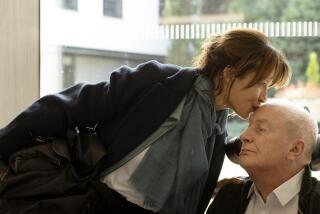Marceau’s Bip spoke volumes
- Share via
There are no details about the death of preeminent French mime Marcel Marceau. We know only that he died in Paris on Saturday at age 84. But anyone who saw him perform knows exactly what happened -- we saw it repeatedly pre-enacted in his life-cycle solo, “Youth, Maturity, Old Age and Death,” a walk through time and a reminder of how quickly even 84 years can pass.
And it wasn’t only his death we saw in this mime classic, it was a glimpse of what we all might hope for in our own: an ending at once peaceful, painless, poetic and, of course, silent.
Marceau was the Shakespeare of silence, adapting the techniques of his mime teacher and mentor, Etienne Decroux, and redefining them in his own image. At age 23, he created Bip, the white-painted Everyman in a striped pullover and battered hat who fused influences dating back to the physical comedy of the commedia dell’arte (16th to 18th centuries) with the achievements of Marceau’s idols from silent films, especially Charlie Chaplin and Buster Keaton.
Like them, Bip couldn’t cope with modern life and failed at just about everything -- including suicide. And his comic misadventures punctuated Marceau’s visionary mimodramas (his word for his pieces). “The Trial,” for instance, began with marvelous quick-change character portraits of opposing attorneys, a defendant and a judge but then evoked something underpinning the courtroom drama and our whole social order, something at once simple and profound: the scales of justice.
Similarly, “The Bird Keeper” initially used Marceau’s miraculous hands to depict soft, fluttering wings but ended with a whole-body statement that went beyond evoking a giant eagle or hawk to show us the essence of mysterious, untamed bird-ness. He made such abstractions utterly real for a contemporary audience used to having literal meanings underlined and overemphasized on film and television -- and that audience glimpsed the depth of its own perceptual resources through his performances.
The power of imagination
If great dancers somehow project themselves into our consciousness, seeming larger than life in the theater and much smaller than we expect when we see them offstage, Marceau drew us to him, trusting the power of imagination (ours as well as his) to make cavernous playhouses feel intimate and intimate ones domestic, places for person-to-person expression. His art embodied the power of stylization, simplification, specificity. And though he could bring us to tears, a tragic vision ennobled him, making him avoid cheap sentimentality.
His father was murdered in a Nazi death camp, and Marceau worked to free Jewish children from the same fate before becoming a soldier. That was the background leading to his decision to abandon conventional acting for the purity of silence one year after the end of World War II. He had seen the worst of life, and his search for a theater of essential statements made him into an essential artist, the unique living touchstone of an ancient tradition.
“Forgive me to feel pride about my art but also great humility,” he wrote in a letter to me in 2002 after I reviewed him at the Geffen, a letter signed “your faithful and silent Bip,” with a tiny sketch of Bip’s trademark hat. He invited me to visit him, but it didn’t happen -- and I’m not sure I’d have recognized him out of makeup.
A double loss
For me, Bip was the reality, Marceau a kind of invisible conjurer. So I’m mourning Bip’s death as much as Marceau’s. But, alas, there’ll be no obituaries for Bip, no tribute to him from the government of France, even though we knew him a lot better than we knew Marceau and will miss him just as much.
Together, they proved to me and to so many others that the realm of art is as palpable as any dimension of existence, and I’d like to believe that both are still walking through time, in whatever reality lies beyond youth, maturity, old age and death. Rest in peace, both of you. We’ll all see you again soon enough.
--
More to Read
The biggest entertainment stories
Get our big stories about Hollywood, film, television, music, arts, culture and more right in your inbox as soon as they publish.
You may occasionally receive promotional content from the Los Angeles Times.








